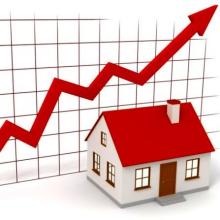
Today's newspapers suggest domestic property prices in Scotland may rise over the next 12 months by an eye-watering average of £40,000.
Rather than despair at the insanity of the current market and the woeful lack of affordable housing, Spurtle decided instead to bury its collective head in the sand and look back to an age when things may not have been any better but at least estate agents' hyperbole was a little easier on the ear.
The pages of the Caledonian Mercury are short on prices throughout the 18th century, but do dwell on this area's delightful rustic setting, fine views, and convenient distance from the city centre and all amenities.
Some of these qualities will be recognised by residents lucky enough to live here today.
*****
To be LET and entered at Whitsunday next,
A HOUSE in PATERSON’s COURT, BROUGHTON, with a small garden, presently possessed by Mrs M’Harg; the house consists of two stories and garrets; in the first story, there is a good parlour and a kitchen, with a pantry, closets, and other conveniences; in the second a genteel dining-room, and two bed-chambers; and in the garret floor there are two rooms with fire places.
For further particulars apply to Mrs Laud the proprietor, at her house in the above court.
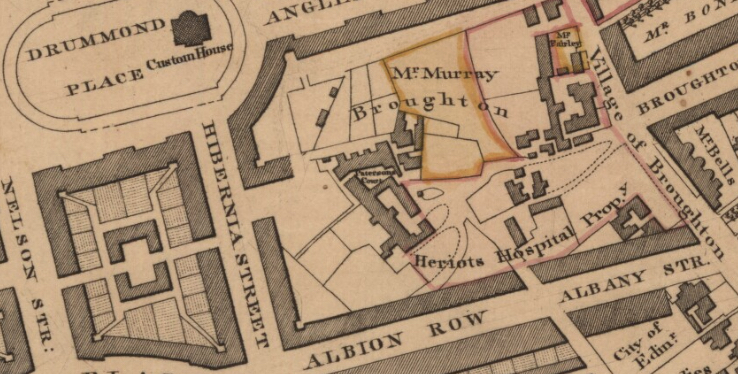
To be LET, for one or more years, and entered to at Whitsunday next,
The HOUSE of CASTRAVEN,
pleasantly situated nigh the turnpike road from Broughton to Canonmills, about three quarters of a mile from Edinburgh, as presently possessed by Alexander Drummond, Esq.; late Consul at Aleppo; consisting of five fire rooms and a kitchen, with a milk-house, stable, byre, and other conveniences for a family; together with a large garden, well walled, and planted with fruit, a grass inclosure. Enquire for further particulars at Alexander Gray, Writer to the Signet, at his house, in the World’s end close, Netherbow, who has power from the proprietor to let the premises.
[15 January 1766]
*****
COUNTRY LODGINGS to LET
TO be LET, and entered to Whitsunday next, or immediately, as tenants incline,
THREE COMMODIOUS LODGINGS, situated
upon the lands of Rosebank, near to Bonnytown, upon the south side of the road leading from Edinburgh to Leith, by the way of Broughton, one of them consists of six fire rooms, a kitchen, and a large cellar, and the flower plot at the back will be let alonst with it; the other two have three rooms and a kitchen each, with a coal cellar belonging to one of them. The lodgings are all well finished, and in good condition, stand in a healthy and pleasant situation, having a large garden just at the back of them, and command an aggreable prospect to the south, have a very easy acess, and are only a short mile distant from Edinburgh.
Walter Ker, Gardener at Rosebank, has the keys, and will show the houses. And for further particulars, apply to Mr. James Fyfe, junior, the proprietor, at his home in Morrocco’s close, Lawnmarket.
[26 April 1769]
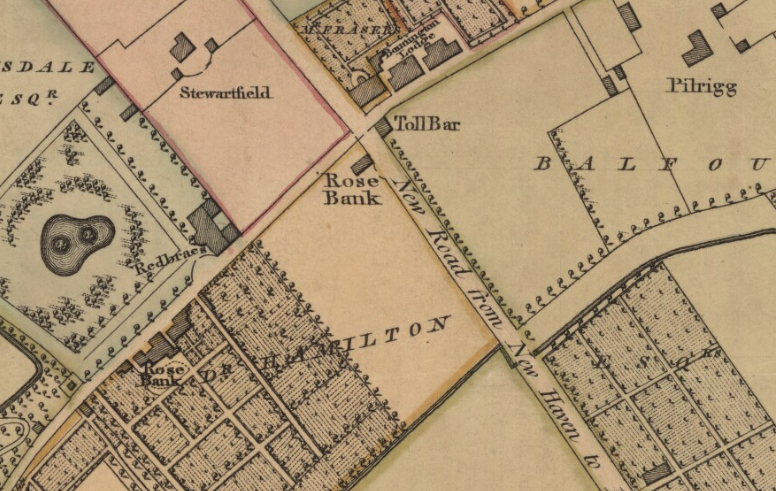
*****
FURNISHED LODGINGS to LET
[…]
III. A LODGING, being the first and ground storey of that tenement, commonly called Courtes’s land, on the west side of Broughton-loan, opposite to Picardy, consisting of a dining room, and drawing room, with a closet, and a concealed bed in each, two bed rooms, kitchen, larder, and two cellars, with a green plot in front, and the use of a pump-well.
[26 October 1771]
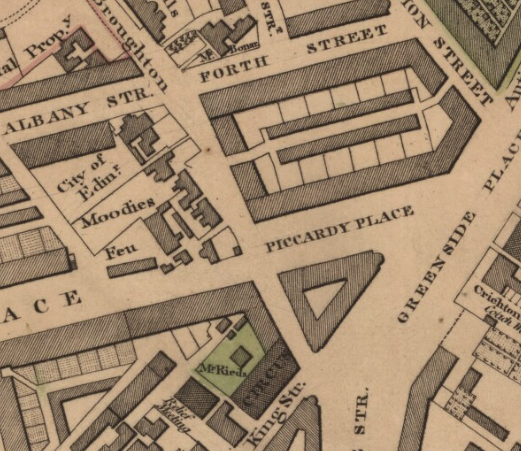
*****
To be LET,
SEVERAL HOUSES, all within themselves,
lying in the village of Broughton, a little to the north of the New Town, pleasantly situated, and plenty of water; commands an agreeable prospect, with some garden ground behind them, with cellars both above and below ground. —Several of these houses to be sold.—For particulars, enquire at Mr. Lauder’s Stay-maker, at his house in Broughton; or at James Chapman Wright there, who will show the houses any time from eight in the morning till six in the evening.
This advertisement not to be repeated.
[28 March 1772]
*****
TO BE SOLD,
Lady Charlotte Erskine’s HOUSE, and INCLOSURES of GAYFIELD, situated between the Walk of Leith and the Broughton turnpike, at an agreeable distance from both roads, and with easy access to either.
From the house there is a most delightful and commanding prospect of the Frith of Forth, town and road of Leith, and the adjacent country. The access to and from Edinburgh is already very good, either by the New Bridge or by the north side of the Canongate, and will still be improved by the new road from the bridge; and though situated quite in the country, is but about 10 minutes walk from the cross.
The house was built within these twelve years, is hansomely and genteely finished; consists of a kitchen, 11 fire rooms, with closets, and excellent garrets with vents, and all necssary out offices, in which there is a large vaulted cellar with catacombs; and both house and offices are made very commodious for a family; there is also coach-house, hay-loft, and stables.—The grounds, which consist of about six acres, are in old grass, and sufficiently fenced, mostly with stone-walls on the out side, and subdivided within by pleasant walks, and well-grown hedges, and young planting: These hold of Herriot’s Hospital, for payments of a feu-duty of two bolls barley per acre. The other grounds consist of a field, well inclosed, of about five acres, with a small dwelling-house thereon, of which there is a tack current for 30 years, at a very moderate tack-duty, and which affords access by the Broughton road, besides access by an avenue by Leith walk.—Both the house and fields are plentifully supplied at all seasons of the year with fine water. The premisses are all in the West Kirk parish, and are not comprehended within the royalty of the city of Edinburgh: and may be seen any day by applying on the day preceding to Young and Trotter, who will also inform of further particulars.
[17 July 1775]
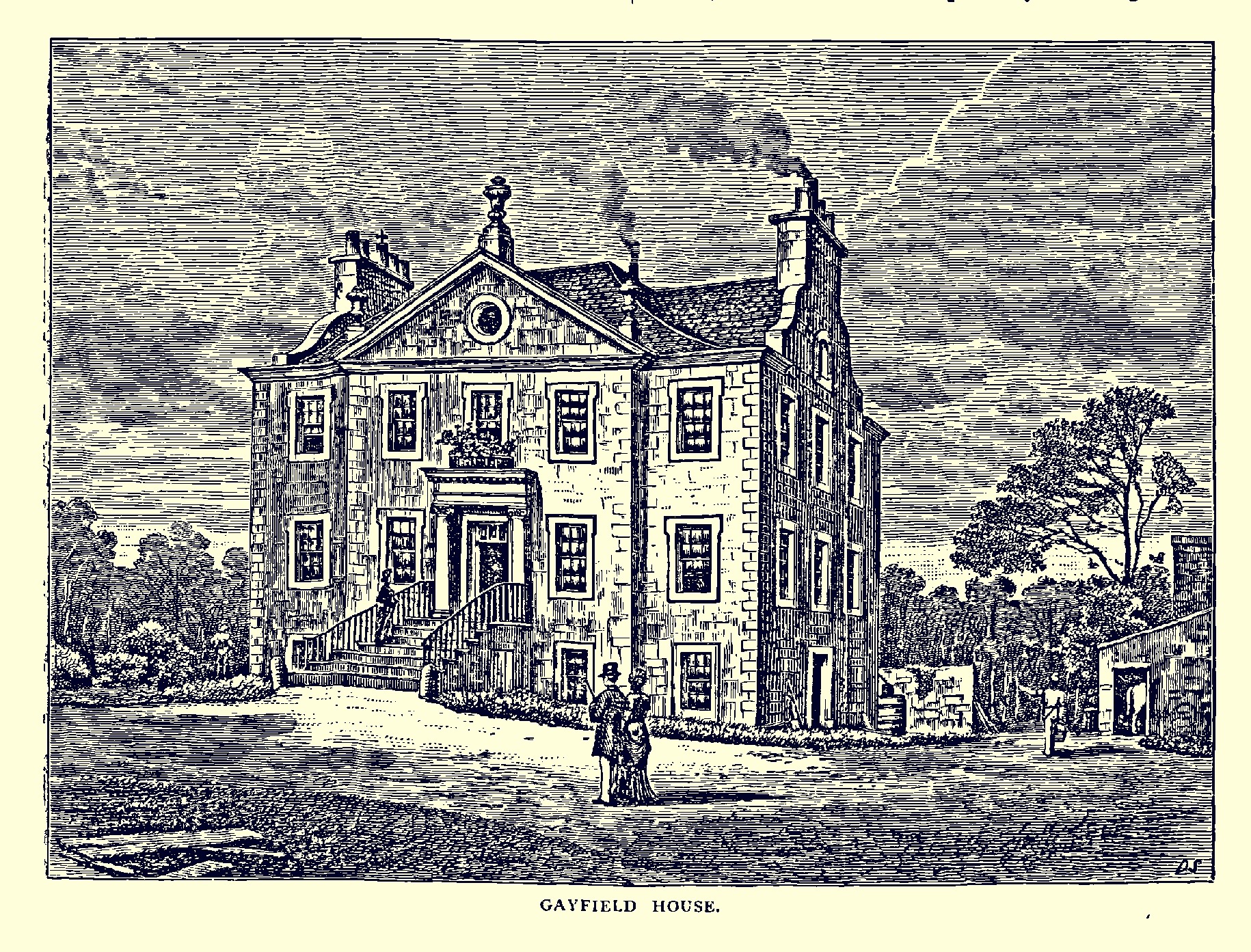
*****
To be SOLD immediately, by private bargain,
THAT NEAT COUNTRY-HOUSE, lately built, with the Garden thereto belonging, pleasantly situated on the road leading from Canon-mills to Silver-mills, near to the entry leading down to Silver-mills. The House consists of two stories and garrets, having a kitchen and three roooms, with a closet to each room on the first flat, and the same accommodation on the second, with the cellars below the house, and an excellent spring-well at the back thereof. The Garden is well inclosed, and the mill-lead to Canon-mills runs past the foot of it. The permisses have access on foot by the New Town, and for carriages by the Canon-mills or Stock-bridge, and are within fifteen minutes walk of the Cross of Edinburgh.
For further particulars, enquire at William Sprott, writer, Morocco’s Close, Canongate.
[21 February 1778]
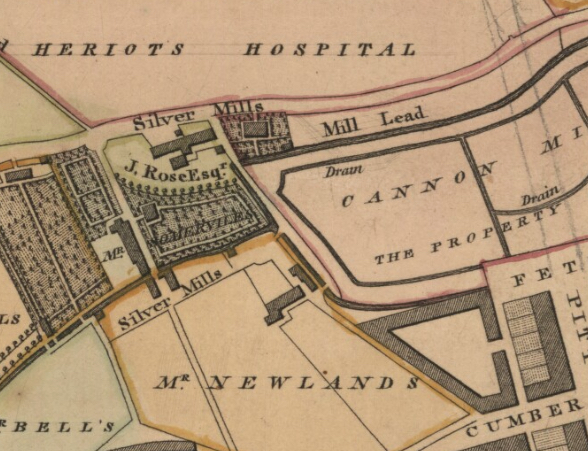
*****
To be SOLD by public voluntary roup, within the Exchange Coffee-house in Edinburgh, upon Wednesday the 8th May next, betwixt the hours of five and six afternoon,
THE House and Lands of POWDER-HALL,
lately belonging to Mr Daniel Seton, merchant in Edinburgh, deceased, lying within the barony of Broughton, parish of St Cuthberts, and shire of Edinburgh.
The Lands are pleasantly situated upon the banks of the Water of Leith, containing about sixteen Scots acres, of a very rich soil, all completely inclosed and divided into several different fields, surrounded with very thriving and beautiful strips of planting. The pleasure-ground is laid out with great taste; and the garden and wall surrounding the pleasure-ground are well stocked with fruit trees of many different kinds, which produce remarkably well.
The House stands upon the Bonnington road to Leith, within twenty-five minutes walk of the Cross of Edinburgh, and consists of a kitchen and eleven fire-rooms, besides five bed-rooms, and two large light closets in the garret story. The dining-room in the second story is about 25 feet by 17; amd the parlour in the first story is about 16 by 14. There are also two cellars, one of them with catacombs, and a complete set of offices, containing stable for six horses, coach-house, carthouse. byre for four cows, milk-house, wash-house, and large laundry, with two servants rooms, and several other conveniences. At the offices is a pump-well, plentifully supplied; and at the head of the entry from the Bonnington road, there is a good gardener’s house of two apartments.
AS ALSO the House called Beaverhall, built upon the said lands, consisting of five rooms and a bed-closet, with a fire place, besides kitchen, back kitchen, laundry, pantry, and two garrets. Contiguous to the house is a large building, with a number of apartments, formerly made use of as a hat-manufactory, which may be easily converted into offices.
The said lands hold of the Governors of Heriot’s Hospital, for payment of an yearly feu—duty of about forty-eight bolls barley bear.
[15 April 1782]
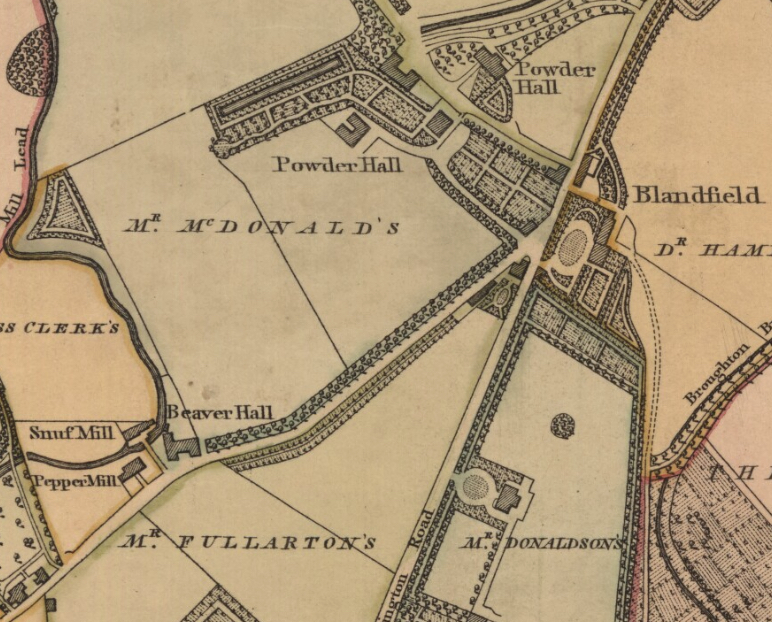
*****
VILLAS
In the Neighbourhood of Edinburgh
And other Subjects for Sale.
To be SOLD, within John’s Coffeehouse, Edinburgh on Wednesday the 24th of January curt. at one o’clock afternoon.
I. THE VILLA OF BROUGHTON PARK, lying on the north side, in the immediate vicinity of Edinburgh; consisting of 3 acres, 2 roods, 37 falls, all well inclosed, at present occupied mostly in nursery.
Upon the premises are a commodious neat Mansion-house, Garden, and suitable offices, possessed by Andrew Leslie seedsman in Edinburgh, the proprietor, besides a smaller dwelling-house, small garden, &c. occupied by a tenant.
[8 January 1798]
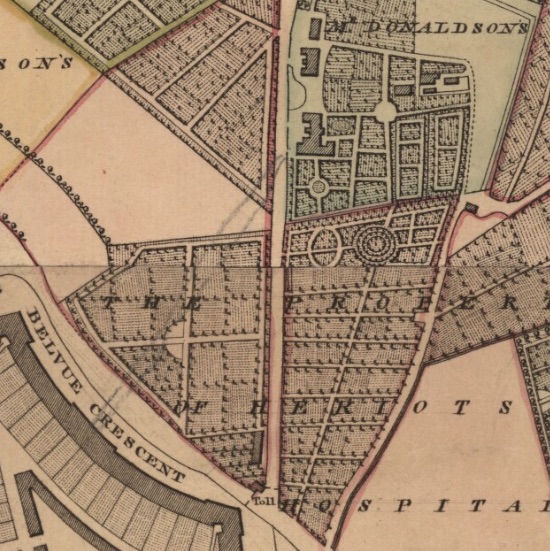
-----
[All maps from Ainslie's 'Old and New Town of Edinburgh and Leith with the Proposed Docks', 1804]
-------------------
Caroline Roussot responds by e-mail: It is interesting to learn just how recent a phenomenon house price inflation has been.
For example, a whole house on Northumberland Street cost about £1,500 when built c.1810, and stayed at that level until around the 1950s with just a dip towards £1,000 at the end of the 19th century.
The Northumberland Street residents, when their street association was more active, did a little exercise in comparing their title deeds. Many of the deeds had the price noted at each sale since 1810, and it was incredibly stable.
Our own title deeds have been transferred to the electronic register so we don't have all that detail, but the flat of a neighbour on Cumberland Street (large 2-bed + study) was around the £300 mark until prices started to take off.
What caused prices to start rising? Perhaps things like government policy (e.g. giving tax relief for mortgage interest), and the growth in building societies, and successive deregulations of lending. In the 19th century, of course, most people rented, but I think also buyers didn't borrow.
If you type in 'price inflation 19th century' to google, the first result is a document from the Office for National Statistics, Consumer Price Inflation since 1750. Actually quite interesting but of course it is essentially for food as this is what records exist for; housing is not included. They are looking at sources such as archives of Smithfields and Covent Garden markets, army provisioning archives etc.
Even so, look at the graph at the bottom RH corner on p40 (Figure 2: Composite Price Index 1750 - 2003 (linear scale))!!
Interesting quote summing up the whole article: "Taken as a whole, in the period between 1750 and 1938, before the start of the Second World War, prices rose by a little more than three times. Since then prices have increased more than forty-fold."
Also this link: http://www.voxeu.org/article/home-prices-1870 - increase in property prices from the mid-20th C due to increases in land values rather than construction cost.
Why didn’t land prices increase before?
What explains the fact that residential land prices remained stable until the mid-20th century and increased strongly thereafter? Our explanation focuses on the different dynamics in land supply in these two periods. From the 19th to the early 20th century, the transport revolution – mostly the construction of the railway network, but also the introduction of steam shipping – led to a massive and well-documented drop in transport costs (Jacks and Pendakur 2010). An important side effect of the transport revolution was to substantially augment the supply of economically usable land.
In the paper, we develop a model with land heterogeneity to demonstrate how a sustained decline in transport costs endogenously triggers an expansion of land, such that the land price may remain low despite continuous growth of income and population. We also show that this land-augmenting decline in transport costs subsides in the second half of the 20th century, so that land increasingly became a fixed factor.
To summarise the above, I'd say that the Northumberland St deeds info could tally with these other pieces of info - evidence of steady upwards movement of prices on food and consumer goods, but not much on land or housing.
 Jane Watson Love Gayfield House - went and visited it when it was still a complete house one September Open Doors day and then worked beside it for about three years when they had sold their back garden to the building we were in and it had been changed into flats which is a shame but inevitable I guess. At one time its gardens was the whole of Gayfield Square.
Jane Watson Love Gayfield House - went and visited it when it was still a complete house one September Open Doors day and then worked beside it for about three years when they had sold their back garden to the building we were in and it had been changed into flats which is a shame but inevitable I guess. At one time its gardens was the whole of Gayfield Square.
 Grant Ballard Fascinating insight to the area, sadly these days I dont think I can afford a tent in Broughton.
Grant Ballard Fascinating insight to the area, sadly these days I dont think I can afford a tent in Broughton.
So, would extending the trams to Newhaven reduce housing costs in the capital? See Roussot comments at end of http://www.broughtonspurtle.org.uk/news/early-steps-broughton-property-ladder …
Caroline Roussot by e-mail: Well certainly it would reduce the aggregate wealth of Edinburghers, in that it will cost far more than the value of the benefits.
 kate @Sea_Penguin5 @suzannejohns @theSpurtle I think they were stable pretty much until late '80s - I also remember when you could get a 'council mortgage'!
kate @Sea_Penguin5 @suzannejohns @theSpurtle I think they were stable pretty much until late '80s - I also remember when you could get a 'council mortgage'!@Sea_Penguin5 @theSpurtle Bought first flat, tiny one bed (Glasgow) in 1979 - £9.5k, sold in '82 for £14.5k. Hard for 1st time buyers then
@suzannejohns @theSpurtle ah well my memory is not what it was
. Suzanne Johnston @suzannejohns
Suzanne Johnston @suzannejohns
@Sea_Penguin5 @theSpurtle It was the pain of paying a mortagage then that I remember most!
@suzannejohns @theSpurtle I do remember lots of people my age (then) in ordinary jobs, were able to buy flats - they can't now, such a shame
@Sea_Penguin5 @theSpurtle @suzannejohns House price/earnings ratio shows affordability. We bought 1st in 1997 :-) http://www.telegraph.co.uk/finance/property/house-prices/11332963/Chart-of-the-day-House-price-to-earnings-ratio-lurches-above-five.html …
@DavidSterratt @theSpurtle @suzannejohns well done - I don't know anyone on minimum wage who can afford to buy a house.
 David Sterratt @DavidSterratt
David Sterratt @DavidSterratt
@Sea_Penguin5 @theSpurtle @suzannejohns We were lucky. It's not fair for 20-35yr olds now, who may have massive student loans too.
@DavidSterratt @theSpurtle @suzannejohns I agree, I feel really sorry for them and very much hope things change for the better
 Paul Bennett It's crazy that British towns and cities got rid of their trams. The trams needs extending so properties just keep their value. One thing I know is there need to be more running. After my trip to the airport last weekI will not be using it again. Slow and so crowded
Paul Bennett It's crazy that British towns and cities got rid of their trams. The trams needs extending so properties just keep their value. One thing I know is there need to be more running. After my trip to the airport last weekI will not be using it again. Slow and so crowded
